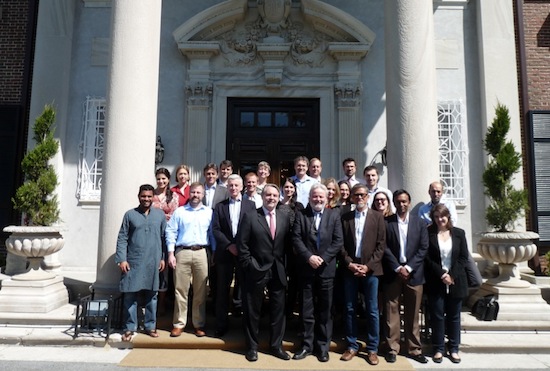
Led by the UN’s Office of Information and Communications Technology (OICT) and organised by the ICT4Peace Foundation, the 2013 Crisis Information Management Advisory Group (CiMAG) meeting was held on 2nd and 3rd May in Glen Cove, New York. Representatives from UNOCC, UNITAR, UNDP BCPR, UNICEF, OHCHR, OICT, OCHA, DFS/DPKO, UNHCR and WFP participated along with, on the second day, representatives from Google Crisis Response, Human Rights Watch, Sahana Software Foundation, Standby Volunteer Task Force, World Bank OpenDRI. Representatives from the New Media Task Force were invited but due to unavoidable circumstances, could not attend.
Overall observations
- It was the best-attended CiMAG retreat thus far, with over 30 participants from the UN and the crisismapping community participating over the two days. The retreat also had the most substantive discussions around information sharing as well as data architecture, a key component of the Crisis Information Management (CiM) strategy of any CiMAG retreat held to date.
- A substantial interest in, enthusiasm for and commitment to CiMS and the CiMAG process by its members.
- The expansion of CiMAG to include new UN agencies, like the UN High Commissioner for Human Rights (UNHCHR) and the Peacebuilding Support Office (PBSO).
- CiMAG members agreed that an annual retreat was insufficient to implement CiMS, collectively address critical issues and move the process forward. Perhaps a bi-annual meeting is required, but more importantly a small secretariat, ideally located at the OICT/CITO’s office to manage the CiM process and facilitate problem solving processes, provide a market place for ideas and solutions, provide strategic input and guidance for members of CiMAG in relation to crisis information management, arrange meetings with interested CiMAG members, including and as required with technology providers.
- The newly established UNOCC and its mandate vis-à-vis the Secretary General on one hand and CiMAG members on the other was considered an excellent driver for implementing CiMS both at HQ and field level. UNOCC agreed to play a catalytic role (“somewhere to put on the hat”), but considers responsibility for CiMS remains with CiMAG members and support role of the CITO/OICT.
- The Humanitarian Exchange Language (HXL), proposed by OCHA, was considered an excellent driver for CiMS, both on the data and technology side.
- Considering the four pillars of CiMS: (1) data architecture work will continue with the building of a COD/FOD/HXL Data Service (with support for OCHA, inter alia, from ICT4Peace and Switzerland’s ETH); (2) Technology Development with inter alia HXL (OCHA with UNHCR and support of ICT4Peace); (3) Stake-holder Management with COI and DHN Summit with support of ICT4Peace; (4) Capacity Building: Curricula Development and courses by OCHA, UNHCR, UNICEF and ICT4Peace respectively, and/or in collaboration.
- DPKO/DFS, a founding member of CiMAG and contributor to CiMS stocktaking report of 2009, highlighted again the high value of COD/FOD/HXL Data Service also for situational awareness creation in peacekeeping and peacebuilding respectively, as well as well peacekeeping cum humanitarian missions. They offered valuable support to its implementation and utilisation. In particular DFS offered to provide to the HXL development: (1) Infrastructure support from Brindisi and/or Valencia; (2) Make available support of in-house developers; (3) Provide GIS capabilities; (4) Contribute financially to establishment of CiMAG Secretariat in CITO office (in collaboration and consultation with Salem Avan).
- ICT4Peace was invited to assist in the establishment of the CiMAG Secretariat in developing TOR for Secretariat and staff, looking for candidates, the development of a tentative work plan from 2013 to 2016 in cooperation with Salem Avan, Susanna Shanahan, Rudy Sanchez and other members of CiMAG.
- ICT4Peace was invited to make a joint field visit in June 2013 with DFS of a peacekeeping mission (MONUSCO) to observe its CiM capabilities and practices from a CiMS perspective, including in its relation with HQ and OCC.
Download the full report from here.

